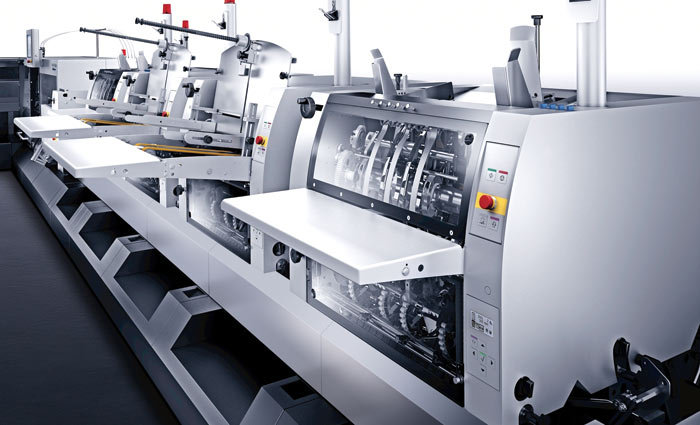
What does it do?
The Heidelberg Stitchmaster ST 500 is an all-purpose, medium- to high-volume wire stitching and trimming line. It offers fast makereadies thanks to a customer-selectable list of automated set-up features. Previous models have either been fully automatic or fully manual.
Brand new features include dynamic linking of feeder offset timing when running up to speed, inline punching options, and a touchscreen control panel. An optional collating function gathers sections of offline perfect binding.
When was it launched and what market is it aimed at?
Heidelberg previewed the ST 500 at Drupa last year, but the production version was only recently released. It is targeted to commercial printers and book binders with a wide range of stitching requirements. As well as conventional wire stitching, the ST 500 offers inline punching for ring binders and calendars, and collation and gathering of sections for separate perfect binding.
How does it work?
It works by insetting pre-folded signatures by laying them onto a travelling gathering chain. Sections from four to 32 pages can be inset, with four- or eight-page cover sections added last. These are stitched and then three-edge trimmed. Two- and three-up production is possible. Trimmed and finished books are usually delivered by a compensating stacker.
The sheet feeder, trimmer, stitcher and stacker have individual drives that can be automated. It uses full servo technology for setting up jobs, controlled by the touchscreen or recalled from memory. Synchronisation of feeder, stitcher, and stacker is automatic. Individual servos enable the ST 500’s dynamic offset feature to automatically time in the feeder as the speed of the gathering chain increases. This is believed to be a unique feature.
How does it fit into factory networks?
There is JDF connectivity via Heidelberg’s Prinect Postpress Manager, which can connect to a broader Prinect factory-wide workflow.
How different is it to other ST models?
The ST 500 replaces the older manual ST 350. It is the first of a new generation of Stitchmasters with selective automation. The entry model is the all-manual ST 100 for formats up to A4 at 9,000cph. The new ST 200 runs at up to 11,000cph. The ST 450 is fully automatic and runs at up to 14,000cph.
How productive is it?
For single copies, the ST 500 runs at 13,000cph, or 26,000cph for two-up. Productivity is aided by fast job changeovers thanks to the servo-driven automation and job recall from memory. Stitching heads can be set up offline in a quick-change chase frame and can then be simply swapped over and ready to go when they have to be changed.
What’s its USP?
The collating function allows individual book blocks to be created before binding. This is said to be a Heidelberg first, “opening up the opportunity for small and medium-sized printers in particular to expand their portfolios beyond saddle-stitching without making an additional investment in gathering”. Three-step indexing through the trimmer allows additional tools for calendar perforation, file hole punching and two- or three-up jobs to be run simultaneously.
The feeder holds sections vertically, spine down, so there is less pressure than with a conventional flat feeder, helping to reduce marking. Chromium-plated sheet guides in the feeder also reduce marking.
How easy is it to use?
This partly depends on the level of automation. The touch panel control uses the Heidelberg Stitchcontrol user interface. All settings can be stored in memory. This means that setting up can be done by skilled operators and loaded into memory, and the actual running can be handled by less skilled staff.
How many are installed?
There’s one running at Druck Pruskil in Gaimersheim, Germany.
Specifications
Max speed 13,000cph
Formats Untrimmed: 80x128mm to 330x500mm; Trimmed: 80x120mm to 315x475mm; Min trimmed with KFT small-format attachment: 55x120mm
Max product thickness 12mm
Feeders Up to 16
Normal stitching heads Up to 6
Loop stitching heads Up to 6
Footprint 10.4×5.8m (L-shaped)
Contact 1300 135 135, au.heidelberg.com
The alternative
Muller Martini Primera
Primera saddlestitchers accept pre-folded sheets and have broadly comparable features to the ST 500, with customised configurations. The range has recently been rationalised to just two: the standard Primera at 14,000cph and Primera 160 at 16,000cph. Both feature high and expandable automation with auto-synchronisation of feeder and gathering chain.
Max speed 14,000cph
Feeders Up to 16
Stitching heads Up to 8
Contact Muller Martini, www.mullermartini.com.au
Comment below to have your say on this story.
If you have a news story or tip-off, get in touch at editorial@sprinter.com.au.
Sign up to the Sprinter newsletter

